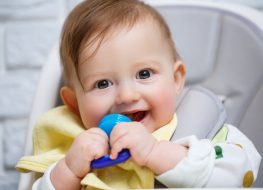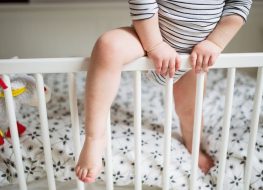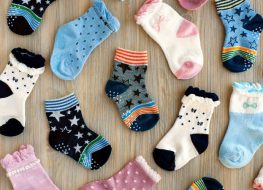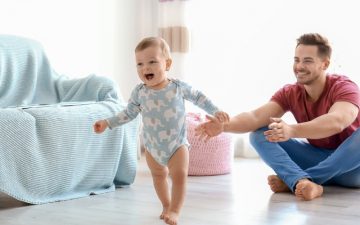
When your baby reaches the 9 to 18-month mark, you’re expecting a milestone that you want to witness your baby achieve—the first steps.
As a parent, you want to make sure you give your baby everything she needs to make those first steps easy. So you buy her a pair of shoes; it makes sense to give her foot the protection and grip she needs when she starts to put those feet in motion.
It’s time to rethink the idea that shoes are the best protection and comfort your baby needs when she starts learning how to walk.
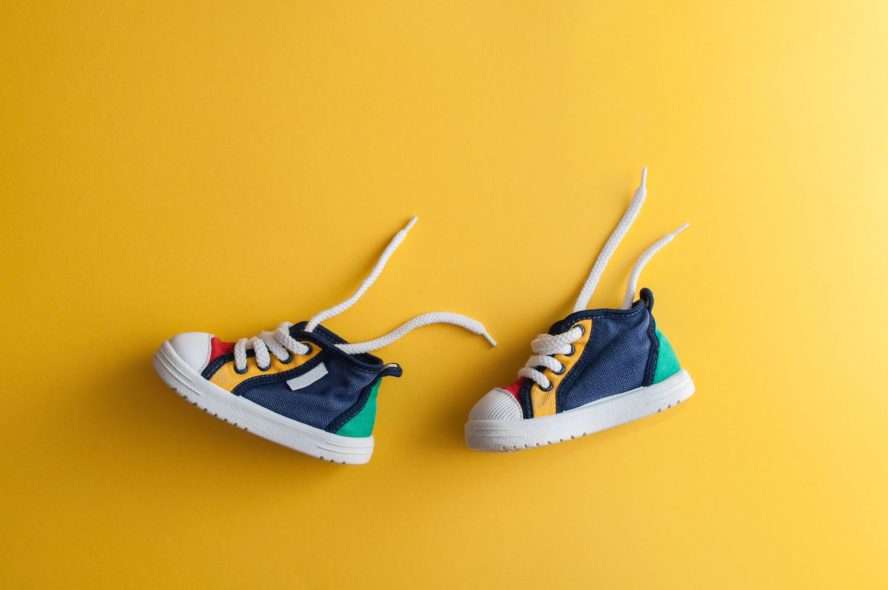
Shoes Aren’t the Solution.
Scientific studies show that babies are better off walking without shoes. Research about the topic of walking barefoot suggests that shoes can cause some changes in the foot’s form, which affects its function. The shoes tend to restrict the foot’s natural spread and are forced to adapt to the shoe’s contour. Adults with certain foot deformities can attest to this. In addition, foot conditions such as bunions are often a result of wearing a tight shoe.
The idea of wearing a shoe for babies should not be taken lightly. Babies, especially when they’re just a couple of months old, still have underdeveloped muscles, ligaments, and bones. Having your baby wear shoes at such an early age may cause unnecessary deformities on foot and may hamper its development.
Let your baby go barefoot until such a time as their muscles, bones, and tissues have developed enough. Then, letting your baby go about without any shoes on will help him develop foot muscles. As soon as they’ve learned how to walk, nature will strengthen their feet and legs if you let them walk around with no shoes on. In addition, your baby will also become more mobile as a result of going barefoot. This maximized range of motion will allow the full development of your baby’s skills for walking.
Going Barefoot
Babies going barefoot will get many benefits by the time they start to attempt their first steps, and the benefits add up as they continuously learn how to walk. Here are some of the advantages your baby can get out of going barefoot.
Develops Arches of the Foot
Foot arches are like the tripods of your body. They keep you stable, support your body’s weight, and help correct your posture as you go with your daily activities.
If your baby walks barefoot, the tarsal and metatarsal bones of your baby’s flat foot get activated. As your baby continues to learn how to walk, the muscles and bones of their feet also develop. In time, it will help develop the longitudinal and the anterior transverse arch of your baby’s foot. This means that if you let your baby walk without shoes on, they’ll eventually develop the arches that will help them stand steady and tall as adults.
Tactile Sense Development
Babies experience the world around them primarily by touch. These bundles of joy pick up, shake, grab, throw, or drop objects as soon as they hold them. That’s how development in infants occurs.
Yet, this tactile development isn’t exclusive to what they can hold on to. Their feet are also a source of tactile sensory development. It’s the baby’s feet that let them discover new textures such as the texture of the floor, the carpet, or the sand. As a result, these new tactile sensory discoveries allow them to discern what surfaces to walk on or avoid.
Develops Their Balance
When a baby wears a shoe during their learning how to walk, it disrupts their balance. Babies tend to look down on the shoes, curious about what they are and why they are attached to their feet. They will also adjust accordingly to this setup.
Barefoot babies tend to keep their heads up and enjoy the surroundings more because they’re not distracted by what’s on their feet. Instead, they focus more on walking straight ahead to the point they want to go to. Soon they’ll learn how to walk naturally from one two or more different points with ease.
Hazard of Walking Barefoot for Babies
As concerned parents, we want to nurture our babies. We want to make sure they’re safe under our watchful eye. So, we can’t help but notice the hazards that can harm our babies due to letting our babies go barefoot. These hazards would lead us to protect our babies by forcing them to wear shoes.
Winter Cold and Frostbites
The feet are one of the most temperature-sensitive parts of our body. A slight drop in temperature, and our feet can tell. This sensitivity is caused by our blood circulation prioritizing heating our core and taking it away from the foot. Unfortunately, it is also applicable to our beloved babies, and it can make them feel uncomfortable.
When the feet are subject to prolonged cold temperatures, frostbites happen. Symptoms include numbness, a firm skin texture, or the skin turns grayish or even white.
Foot Injuries
An exposed foot is prone to foot injuries. Common injuries caused by an exposed foot are:
Stubbed toe – This happens when the toe is kicked on a hard surface such as a wall, a door, or the edges of furniture. The stubbed toe can be very painful initially, but the pain doesn’t last for very long.
Puncture wounds – When walking on surfaces filled with small debris, the foot may step on a sharp object and may cause a puncture wound. This open wound may not only cause bleeding and discomfort, but it may also become an entry point for infection.
Dislocation – This may be caused by tripping forward or sideways or even twisting your foot heavily. The foot dislocates from the ankle and may result in being incapacitated.
Bacteria and Infections
A foot that’s exposed can attract bacteria on the ground where it walks on, especially if it’s an outdoor setting. Many outdoor places harbor bacteria and fungi that can cause skin infections and even worms. In addition, places where there is soil or dirt, such as outdoor parks or even your backyard, are places where bacteria can thrive.
Above are several reasons that convince parents to buy baby shoes. They want to keep their babies healthy and away from injuries. But while shoes do provide maximum protection, it hampers your baby’s development.
There’s another solution, baby socks.
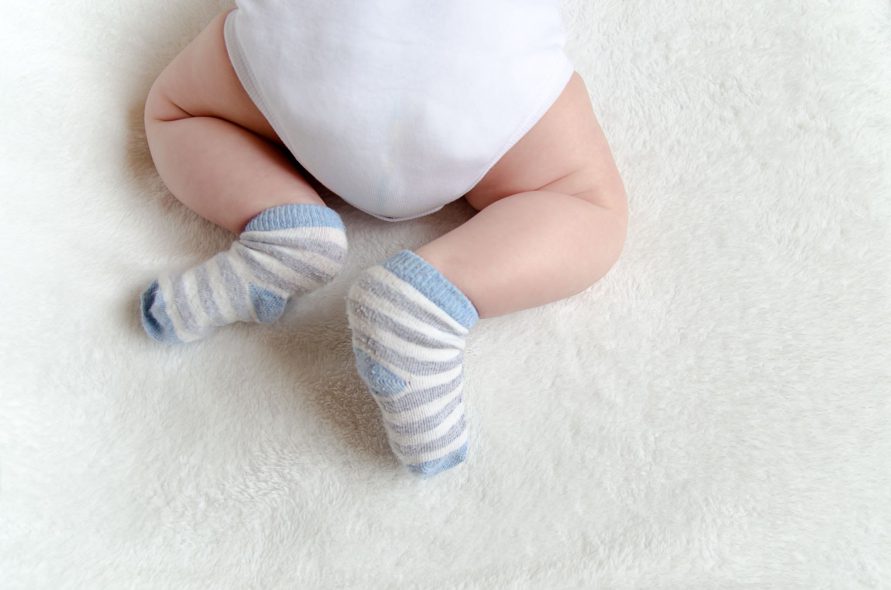
Meeting Halfway: Get the Best Socks For Babies Learning to Walk
Baby socks are the compromise between letting your baby walk barefoot and wear shoes. Some of the best socks for babies learning to walk have these qualities:
Flexible and Comfortable
The best baby socks adjust to your baby’s feet. That means your baby’s foot doesn’t have to be cramped in a tight shoe. Socks provide the protection and comfort you want your baby to have while she learns how to walk.
Regulates Temperature
The sock’s fabric acts as a layer of protection that traps the heat produced by the foot and uses it to regulate the baby’s temperature. It also keeps the cold wind out of your baby’s foot. As a result, your baby will feel utmost comfort and ease while protecting her against cold feet and frostbites.
Protects Your Baby’s Feet From Injury
Grip socks are made for movement. You can wear them and dance around without fear of falling or tripping over. In addition, you can purchase baby grip socks for walking so you can prevent your baby from foot and ankle injuries and ensure she enjoys the process of learning how to walk.
Prevent From Slipping and Falling
The best baby socks are made of materials that prevent them from falling injuries. Although there’s a lot of non-slip socks for babies learning to walk, each has its own merits. If she’s still trying to learn how to take those baby steps, you can get non-slip baby girl socks. This ensures you eliminate or minimize any falls and make sure she keeps on trying.
The Joy of Seeing Your Baby Walk
Your baby is the most important human being in your life. Seeing her take her first steps can bring you joy and pride. On the other hand, seeing her fall and struggle will make you feel sad for you and your baby. Her success is yours, too. And you want to make sure that you’re doing everything you can to support her along the way. During her journey to the first steps, give her the comfort, safety, and protection she needs while also letting nature teach and mold her. This is expressed fully when you purchase her first baby socks.

